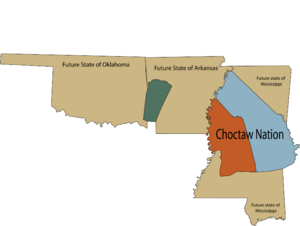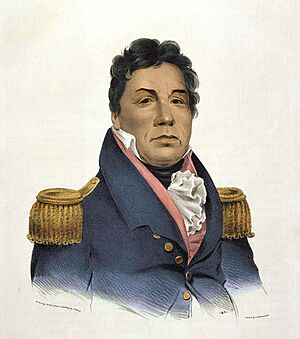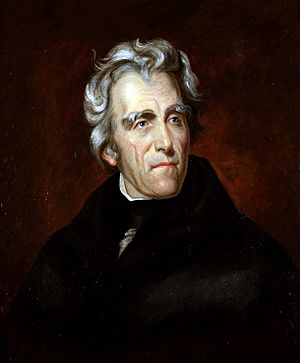Treaty of Doak's Stand facts for kids
The Treaty of Doak's Stand was an important agreement signed on October 18, 1820. It was made between the United States government and the Choctaw Native American tribe. Through this treaty, the Choctaw agreed to give up about half of their traditional homeland. This land was located in what is now the state of Mississippi.
In October 1820, two U.S. representatives, Andrew Jackson and Thomas Hinds, met with Choctaw leaders. Their goal was to get the Choctaw to give up a large part of their land. They met at a place called Doak's Stand, which was on the Natchez Trace. The main Choctaw chiefs present were Pushmataha, Mushulatubbee, and Apuckshunubbee. These chiefs represented the three main groups of the Choctaw people.
Contents
Negotiating the Treaty
The discussions for the treaty began on October 10. Andrew Jackson, whom the Choctaw called "Sharp Knife," spoke to more than 500 Choctaw people. Jackson suggested that the Choctaw trade their land in Mississippi for new land in what is now Arkansas.
However, Chief Pushmataha disagreed with Jackson. He said that the land west of the Mississippi River was not good. Pushmataha explained, "I know the country well... The grass is everywhere very short... There are but few beavers, and the honey and fruit are rare things."
Jackson then tried to pressure the Choctaw to sign the treaty. He told them that many Choctaw were already moving west. He warned them that if they refused, their nation would be "destroyed." After these strong words, the chiefs finally signed the treaty on October 18, 1820.
One important part of the treaty, Article IV, talked about the Choctaw becoming U.S. citizens in the future. This would happen when they became "civilized and enlightened." This idea later influenced another treaty in 1830, called the Treaty of Dancing Rabbit Creek.
ART. IV. The boundaries hereby established between the Choctaw Indians and the United States, on this side of the Mississippi river, shall remain without alteration until the period at which said nation shall become so civilized and enlightened as to be made citizens of the United States, and Congress shall lay of a limited parcel of land for the benefit of each family or individual in the nation. ...
—Treaty of Doak's Stand, 1820
What the Treaty Said
The treaty started by saying that the U.S. President wanted to help the Choctaw. He wanted to set up schools for them and help them continue as a nation. This would happen by trading some of their land for new land across the Mississippi River. This new land would be for those who hunted and did not farm.
Here are the main points of the treaty:
- The Choctaw gave up land in Mississippi to the U.S.
- The U.S. gave land in what is now Arkansas to the Choctaw nation.
- A Choctaw guide would help mark the new land boundaries.
- These boundaries would not change until the Choctaw became U.S. citizens.
- Choctaw people who moved to the new western lands would receive supplies. These supplies included corn, blankets, kettles, rifles, and ammunition for one year.
- The U.S. would send an agent, goods, and a blacksmith to the Choctaw.
- Money from selling some Choctaw lands would help support Choctaw schools.
- The Choctaw nation would receive $6,000 each year for 16 years.
The New Choctaw Land
The land given to the Choctaw in Arkansas was located between the Red River in the south and the Canadian and Arkansas Rivers in the north. The western border of this land went towards the source of the Canadian River. At that time, this area was part of Mexico.
The land that the U.S. actually owned started where the Canadian and Red Rivers crossed the 100th Meridian West. This is now the border between Oklahoma and Texas.
Along the Red River, the border went east to where the Little River joins the Red River, near what is now Fulton, Arkansas. Then, the border went northeast to the eastern edge of the Cherokee Nation's land. That Cherokee land started where Point Remove Creek met the Arkansas River, near what is now Morrilton, Arkansas. From there, the border followed the Arkansas River east, through Fort Smith, to where the Canadian River joins the Arkansas. Finally, it followed the Canadian River to its source, or to the 100th Meridian.
Who Signed the Treaty
The important people who signed the Treaty of Doak's Stand were:
- Andrew Jackson
- Thomas Hinds
- Apuckshunubbee
- Pushmataha
- Mushulatubbee
See also




